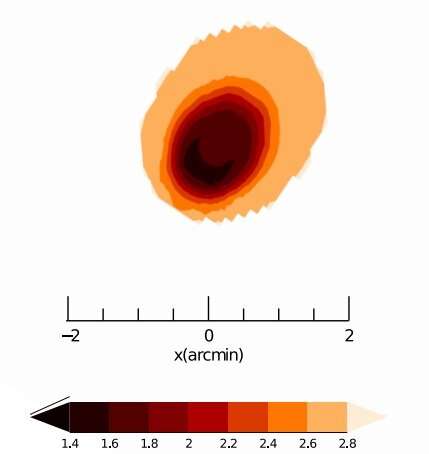December 5, 2019 report
Astronomers probe the nature of a peculiar pulsar wind nebula

Using ESA's XMM-Newton spacecraft, astronomers have investigated the nature of a peculiar pulsar wind nebula (PWN) in the supernova remnant (SNR) CTB 87. Results of the study, presented in a paper published November 26, shed more light on the morphology and spectral properties of this object.
SNRs are diffuse, expanding structures resulting from a supernova explosion. They contain ejected material expanding from the explosion and other interstellar material that has been swept up by the passage of the shock wave from the exploded star.
PWNe are nebulae powered by the wind of a pulsar. Pulsar wind is composed of charged particles; when it collides with the pulsar's surroundings, in particular with the slowly expanding supernova ejecta, it develops a PWN. X-ray studies have the potential to reveal PWNe and associated SNRs, which could provide important information about pulsar parameters and interaction of relativistic pulsar winds with the ambient medium.
Located some 20,000 light years away in the Milky Way's Perseus spiral arm, CTB 87 (also known as G74.9+1.2) is an evolved SNR hosting a PWN associated with the point source CXOU J201609.2+371110, with a current status of a pulsar candidate. In order to get more insights into the nature of this PWN, especially its morphology and evolutionary stage, a team of astronomers led by Benson Guest of the University of Manitoba in Winnipeg, Canada, decided to perform X-ray observations of this nebula using two European Photon Imaging Camera (EPIC) detectors onboard XMM-Newton.
"Here, we use a deep XMM-Newton observation to examine the morphology and evolutionary stage of the PWN and to search for thermal emission expected from a supernova shell or reverse shock interaction with supernova ejecta," the astronomers wrote in the paper.
Observations confirmed a comet-like morphology of CTB 87, suggested by previous studies. However, this SNR is known to be embedded in a thermal shell that was not observed on the images provided by XMM-Newton. In general, the observations did not find evidence of thermal X-ray emission, which supports the scenario of expansion into a stellar wind bubble.
The spectral index map of the PWN unveiled high-resolution hard structures close to CXOU J201609.2+371110, and an overall steepening of the photon index away from it. A low surface brightness emission was also found to the south of this source, which suggests diffusion of particles in that direction.
All in all, the researchers concluded that the the PWN is evolved and elongated, and moves toward the observer through low-density SNR material. However, many questions about this peculiar PWN remain unanswered, mainly regarding its properties. Therefore, the authors of the paper propose further timing and deep observations of this system.
"In particular, the spin properties of the pulsar candidate and a measurement of its proper motion will be crucial. Furthermore, a deeper X-ray spectroscopic study extending to larger distances from the pulsar candidate may reveal weak thermal X-ray emission from this system," the astronomers concluded.
More information: Deciphering the Nature of the Pulsar Wind Nebula CTB 87 with XMM-Newton, arXiv:1911.11829 [astro-ph.HE] arxiv.org/abs/1911.11829
© 2019 Science X Network





















